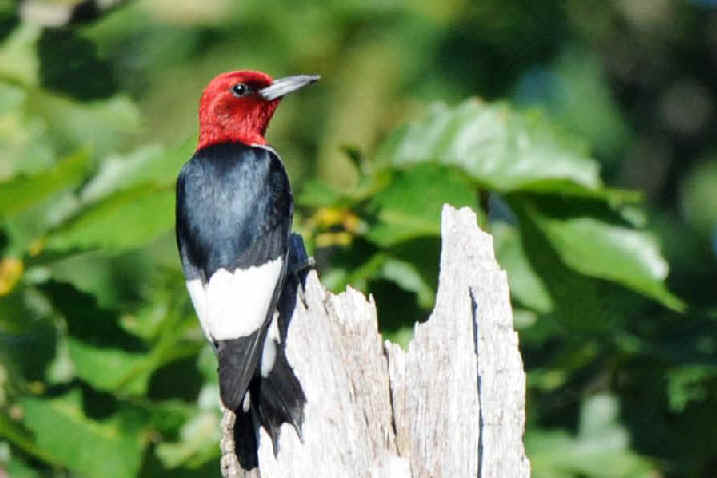The BIRDLINE, by ARMAS HILL
Migrants, including Woodpeckers, Hawks, and Birds in the Night
Armas Hill has presented the "Birdline", originally from
Philadelphia, on the phone and internet for over 3 decades, and on the radio
in Delaware for about 10 years.
Links:
A
List & Photo Gallery of North American Birds, in 6 Parts
A
List & Photo Gallery of North American Mammals


An adult Red-headed
Woodpecker
(photo by Howard Eskin)
The Birdline
for September 30, 2011:
Alexander Wilson,
after whom birds are named (a storm-petrel, plover, warbler, and
snipe) has been called the "Father of American
Ornithology". But he came, as a young man, from
Scotland.
In July 1794, he arrived by ship into New
Castle, Delaware, on the Delaware River.
He spent the night in Wilmington, which at that time had 13 flour mills,
making it the greatest flour producer in the New World. Near one of the
those mills by the Brandywine Creek, the next morning, a bird
caught Wilson's eye. He had never seen a bird like it, anywhere that
he had been. He wrote that it was "the most beautiful bird he had
ever seen", with its brilliant red, white, and black.
It was, what would be called, a RED-HEADED WOODPECKER.
Wilson shot it. He immediately regretted doing so.
Overhead, other RED-HEADED WOODPECKERS were "diving and
vociferating, pursuing and playing, rattling on the tree trunks and
screaming in the woods, constantly active, gay, and frolicsome".
"Birds were everywhere", Wilson also wrote. MOCKINGBIRDS, he
said, were also there, near Wilmington in 1794 - which was at
that time about the extreme northern edge of their range.
Now, RED-HEADED WOODPECKERS are not at all common in northern Delaware in
the summer. But some do occur there in the fall, as they migrate south.
This past week: on an island in the Delaware River, by New
Castle, where Wilson landed, a RED-HEADED WOODPECKER was seen
on September 27. That island, called Pea Patch Island.
That same day, also in northern Delaware, further west, 2
RED-HEADED WOODPECKERS were seen at Ashland, an adult early in the
day, and an immature later.
And few miles further west, in northeast Maryland, a couple days later,
on September 29, 9 RED-HEADED WOODPECKERS were
observed, flying by, on their way south, at a place called Turkey
Point, at the top of the Chesapeake Bay.
Previously here, this month, the plover named after Wilson was noted as
being in southern New Jersey. That WILSON'S PLOVER was
seen again on September 27 at Stone Harbor Point.
Previously here, this month, a VIOLET-GREEN SWALLOW was reported as
being at Cape May, New Jersey. There was another sighting of that
species in the Cape May area on September 27, in flight at Stone Harbor
Point, again a dull immature bird.
Previously here, this month, a YELLOW-HEADED BLACKBIRD was noted as
being at Brigantine National Wildlife Refuge in New Jersey. On September
27, 2 Yellow-headed Blackbirds were seen there
together, a male and a female, both juveniles.
Previously here, this month, a TOWNSEND'S WARBLER was noted as being
along the Maryland seacoast. On September 28, further north, along the New
Jersey seacoast, a first-year TOWNSEND'S WARBLER was seen at
Sandy Hook, hanging out with PALM WARBLERS (both EASTERN
& WESTERN) and a TENNESSEE WARBLER.
Seen at Sandy Hook, the next day, September 29, were 2 MISSISSIPPI KITES
and a DICKCISSEL.
On September 29, in southernmost New Jersey, a BLACK-THROATED GRAY
WARBLER was seen at Cape May, at Higbee Beach.
A birder in southeastern Pennsylvania, at a marsh in Bucks
County, this past week, found himself surrounded by SORAS, with about 30
calling.
Several EVENING GROSBEAKS, this week, were in Hillsborough, New
Hampshire on September 25. Hopefully that species will be coming
south in the eastern US.
A CURLEW SANDPIPER was in New Hampshire, at Hampton, September 17 to 23.
A CLAY-COLORED SPARROW was in Concord, New Hampshire on September 27.
Another was in that state at Hampton Beach, September 25 & 26.
In central Pennsylvania, a CLAY-COLORED SPARROW was found in Juniata
County on September 28.
A CLAY-COLORED SPARROW was seen at Cape Henlopen, Delaware, on September
27.
A RUFOUS HUMMINGBIRD was reported as being at a feeder near Lexington,
Virginia on September 23.
Another bird more often seen in western North America flew by Hawk
Mountain Sanctuary on September 26, a SWAINSON'S HAWK. It was a juvenile
dark morph.
Now, at the end of September, most of the BROAD-WINGED HAWKS in
eastern North America have already flown by.
Here's a brief synopsis of some BROAD-WINGED
HAWK tallies at various hawk-watches,
thus far this season:
First, in Pennsylvania, BROAD-WINGED HAWKS: And first along the
Kittatinny Ridge:
At Hawk Mountain Sanctuary, in Kempton,as of
September 29: 13,028
On September 17 at Hawk Mountain: 2,813
BROAD-WINGED HAWKS
At Waggoner's Gap, southwest of Harrisburg, as of
September 29: 12,875
On September 17 at Waggoner's Gap: 3,176
BROAD-WINGED HAWKS.
At Bake Oven Knob, near Germansville, as of September
27: 8.168
On September 19 at Bale Oven Knob: 1,405
BROAD-WINGED HAWKS.
At Second Mountain, at Indiantown Gap, as of September
29: 7,104
On September 17 at Second Mountain: 1,769
BROAD-WINGED HAWKS.
At Tuscarora Summit, as of September 29: 4,533
On September 17 at Tuscarora Summit: 1,245
BROAD-WINGED HAWKS.
At Militia Hill, at Fort Washington, as of
September 27: 4,251
On September 17 at Militia Hill: 2,609
BROAD-WINGED HAWKS.
At Rose Tree Park, in Media, as of September 29: 2,565
At Tussey Mountain, at State College, as of September
27: 1,763
At Stone Mountain, in Allendale, as of September 29: 1,541
On September 17 at Stone Mountain: 696
BROAD-WINGED HAWKS
In Reading, Pennyslvania, 1,163
BROAD-WINGED HAWKS were counted from Mount Penn on September 17 by
members of the Baird's Ornithological Club. Nearby, 395
were counted that day above the Green Hills Golf Course in southern
Berks County.
Away from a Pennsylvania ridge, and away from a hawk-watch:
4,765 BROAD-WINGED HAWKS were counted over Strasburg,
in Lancaster County PA, on September 18,
mostly before noon.
In New Jersey, along the Kittatinny Ridge, at Raccoon
Ridge, in Blairstown, as of September 26: 14.001
A big day at Raccoon Ridge was September 18
with 7,977 BROAD-WINGED HAWKS.
On September 16, at Skotch Plains, New Jersey, there
were well over 1,000 BROAD-WINGED HAWKS.
Some notable big flight days for BROAD-WINGED HAWKS, north of
Pennsylvania and New Jersey:
On September 16 at the Quaker Ridge Hawk Watch, in Greenwich,
Connecticut: 6,100
That same day in Stratford, Connecticut: over
8,000
On September 17 at the Chestnut Ridge
Hawk Watch, in Bedford, New York: 9,600
And that same day at Hook Mountain, in Rockland
County, New York: 14,670
South of Pennsylvania and New Jersey:
On September 18, in Manchester, Carroll County,
Maryland, 2,974 BROAD-WINGED HAWKS were
tallied, not at a hawk watch, but from a birder's front yard.
On September 17, at the Susquehanna State Park in Maryland,
352 BROAD-WINGED HAWKS were counted during 30 minutes in
the morning.
At the Cape Henlopen Hawk Watch, in Delaware, along the seacoast, as
of September 29, there were no BROAD-WINGED
HAWKS.
But as of that date, at Cape Henlopen, there were 1,248 OSPREY.
Comparatively, 352 OSPREY flew south past Hawk Mountain, as of
September 29.
Earlier this month, here, we told of WHIMBREL being tracked by
transmitting devices during their migration south to the Caribbean and Central
and South America. Well, OSPREY are also being tracked that way as
well during their southward migration to those same places.
OSPREY, having left New England, are already in the
Caribbean and South America.
On September 28, one that traveled across the Caribbean
arrived in Colombia, South America. She's a
juvenile, who was tagged on Martha's Vineyard, Massachusetts.
Another OSPREY, from the island of Nantucket, Massachusetts,
is now in Cuba.
More tracking, during the last few days, has shown that another OSPREY
from Martha's Vineyard is now "way down" in Brazil,
and one that nested at Cape Henlopen, Delaware is now in Amazonian
Brazil.
For more info, you might check the website: www.bioweb.uncc.edu
referring to the project, by Rob
Bierregaard, Jr. of the Biology Dept. of the University of North
Carolina in Charlotte.
Out thanks to Roy Frock, of Bucks County, Pennsylvania,
for bringing this interesting story to our attention.
Another fascinating topic, in the vein of bird migration, is the night-time
migration of many birds, including, but not exclusively small
birds, such as THRUSHES, and others too.
In the central Adirondacks of New York, back on
September 9, between midnight and 1am, birds in migration were listened
to "in awe". At that place, where there was no human noise
other than an occasional jet going over, there were also no lights
to diminish the individual stars and planets, and the bright
Milky Way.
There were about 10 to 30 BIRD CALLS per minute, passing by overhead.
Most of the birds that were heard were SWAINSON'S THRUSHES, high in the
sky. Also heard were ROSE-BREASTED GROSBEAKS, SCARLET TANAGERS, and many WARBLERS.
When some fog came in, some of the birds were so low that the birder
felt as if she could almost reach out and touch them as they flew by!
In western Pennsylvania, between about 10pm and 2am on
September 16, another birder was thrilled to experience a nocturnal bird
migration in his yard.
Among the birds he heard were SEMIPALMATED PLOVER and SOLITARY
SANDPIPER. A SOLITARY SANDPIPER was so close that it sounded as if
it were on a neighbor's roof.
PASSERINE MIGRATION was extraordinarily heavy, with all 5
species of "SPOT-BREASTED THRUSHES", with well over
1,000 individual calls, mostly SWAINSON'S THRUSHES. Also many
WARBLERS, buzy INDIGO BUNTING TYPES, SCARLET TANAGER, a few
ROSE-BREASTED GROSBEAKS, CHIPPING SPARROWS, and a number of birds
unidentified.
A pair of what appeared to be HERONS crossed in front of the Moon.
Many PASSERINES were seen flying in front of the Moon, as were probably some
"larger SHOREBIRDS".
Later in the month, during the night on September 27, at Cape
May, New Jersey, hundreds of SWAINSON'S THRUSHES were heard,
with VEERIES, and a few BICKNELL'S and GRAY-CHEEKED THRUSHES.
At Hawk Mountain, Pennsylvania, very early, as the
nocturnal migration was coming to a close, from about 5:30 to 6:30
in the morning, there was a remarkable descent of
THRUSHES from their night flight.
About 1,200 flight calls of SWAINSON'S THRUSHES were heard, as were
about 200 calls of WOOD THRUSHES, about 25 calls of GRAY-CHEEKED
THRUSHES (in 2 distinct clusters), and a few calls of SCARLET TANAGER
and ROSE-BREASTED GROSBEAK.
Later, during daylight hours at Hawk Mountain, about 10 SWAINSON'S
THRUSHES were seen (by the same person), as were 2 HERMIT THRUSHES, a
WOOD THRUSH, and a GRAY-CHEEKED THRUSH.
But at night, certainly a lot goes by in the sky as we sleep!
Armas Hill has presented the Birdline, originally from Philadelphia, on
the phone and internet for decades (3), and on the radio in Delaware for
years (10).
The Birdline (and the Natureline) are
affiliates of Focus On Nature Tours.
Earlier mention was made of OSPREY going to the Caribbean and to Central
and South America. Upcoming Focus On Nature (FONT)
Tours are also going to each of those places.
Info is in the website: www.focusonnature.com
Also, kindly scroll down the
right-side of the home-page to see some previous editions of Birdlines
and Naturelines. More from our vast archives are
yet to be added, particularly Features from
the radio over the years.
To
Top of Page


